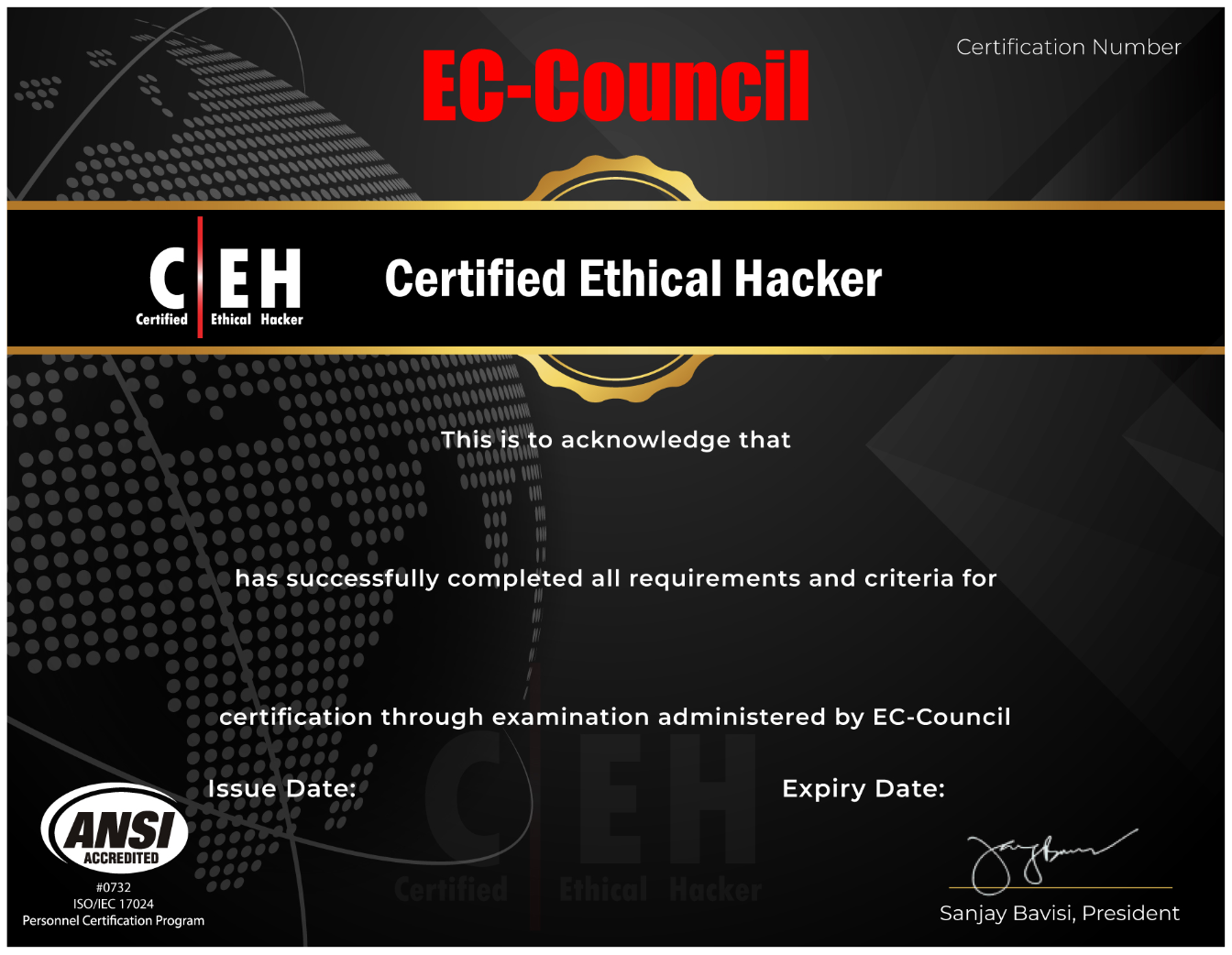EC Council Certified Ethical Hacker (CEH) v12
Course Overview

The Certified Ethical Hacker has been battle-hardened over the last 20 years, creating hundreds of thousands of Certified Ethical Hackers employed by top companies, militaries, and governments worldwide.
In its 12th version, the Certified Ethical Hacker provides comprehensive training, hands- on learning labs, practice cyber ranges for engagement, certification assessments, cyber competitions, and opportunities for continuous learning into one comprehensive program curated through our new learning framework: 1. Learn 2. Certify 3. Engage 4. Compete.
The C|EH v12 also equips aspiring cybersecurity professionals with the tactics, techniques, and procedures (TTPs) to build ethical hackers who can uncover weaknesses in nearly any type of target system before cybercriminals do.
Learning Outcomes
- Pre-configured vulnerable websites
- Vulnerable, unpatched operating systems
- Linux Ubuntu
- Fully networked environments
- 3,500+ hacking tools
- And more...
Exam Information
C|EH® Master
Upon completing the C|EH® (Master) program, consisting of the C|EH® and C|EH® (Practical), the C|EH® (Master) designation is awarded. C|EH® Masters have shown proficiency at a master level in the knowledge, skills, and abilities of ethical hacking with a total of 6 hours of testing to prove their competency. The top 10 performers in both C|EH® and C|EH® Practical exams are featured on the C|EH® Master Global Ethical Hacking Leader Board.
Course Content & Modules
Introduction to Ethical Hacking
Cover the fundamentals of key issues in the information security world, including the basics of ethical hacking, information security controls, relevant laws, and standard procedures.
Footprinting and Reconnaissance
Learn how to use the latest techniques and tools to perform foot printing and reconnaissance, a critical pre-attack phase of the ethical hacking process.
Scanning Networks
Learn different network scanning techniques and countermeasures.
Enumeration
Learn various enumeration techniques, such as Border Gateway Protocol (BGP) and Network File Sharing (NFS) exploits, and associated countermeasures.
Vulnerability Analysis
Learn how to identify security loopholes in a target organization's network, communication infrastructure, and end systems. This module also covers different types of vulnerability assessment and the tools used for them.
System Hacking
Learn about various system hacking methodologies, including steganography, steganalysis attacks, and techniques for covering tracks. These methods are used to discover system and network vulnerabilities.
Malware Threats
Learn about different types of malware (such as Trojans, viruses, worms, etc.), Advanced Persistent Threats (APT), and fileless malware. The module also covers malware analysis procedures and countermeasures.
Sniffing
Learn about packet-sniffing techniques and how they are used to discover network vulnerabilities. It also covers countermeasures to defend against sniffing attacks.
Social Engineering
Learn social engineering concepts and techniques, including how to identify theft attempts, audit human-level vulnerabilities, and suggest social engineering countermeasures.
Denial-of-Service
Learn about different Denial of Service (DoS) and Distributed DoS (DDoS) attack techniques. This module also covers the tools used to audit a target and devise DoS and DDoS countermeasures and protections.
Session Hijacking
Understand various session hijacking techniques used to discover network-level session management, authentication, authorization, and cryptographic weaknesses, along with associated countermeasures.
Evading IDS, Firewalls, and Honeypots
Get introduced to evasion techniques for firewalls, Intrusion Detection Systems (IDS), and honeypots. It also covers the tools used to audit a network perimeter for weaknesses and relevant countermeasures.
Hacking Web Servers
Learn about web server attacks, including a comprehensive attack methodology used to audit vulnerabilities in web server infrastructures and countermeasures.
Hacking Web Applications
Learn about web application attacks, including a comprehensive web application hacking methodology used to audit vulnerabilities in web applications and countermeasures.
SQL Injection
Learn about SQL injection attacks, evasion techniques, and SQL injection countermeasures.
Hacking Wireless Networks
Understand different types of wireless technologies, including encryption, threats, hacking methodologies, hacking tools, Wi-Fi security tools, and countermeasures.
Hacking Mobile Platforms
Learn Mobile platform attack vector, android and iOS hacking, mobile device management, mobile security guidelines, and security tools.
IoT and OT Hacking
Learn different types of IoT and OT attacks, hacking methodology, hacking tools, and countermeasures.
Cloud Computing
Learn different cloud computing concepts, such as container technologies and server less computing, various cloud computing threats, attacks, hacking methodology, and cloud security techniques and tools.
Cryptography
Learn about encryption algorithms, cryptography tools, Public Key Infrastructure (PKI), email encryption, disk encryption, cryptography attacks, and cryptanalysis tools.
Earn Your Industry-Recognized Certificate
Upon successfully passing the examination for this course, participants will be awarded a certificate, an example of which is shown below.




